Related Tags
How to get better at guitar using the CAGED system (Part 4)
In Part 4 of this lesson series about the CAGED System you’ll learn about chord construction, some more triads, 7th chords and how to add some upper extensions.

To get the most out of this lesson you should understand how the major and minor triads, pentatonic scales, major scale and the chromatic scale can be found within the CAGED System. Check out the first three in this article series if you don’t already know these things.
You hopefully know that a major triad contains the root, major 3rd and perfect 5th, as well as by lowering the 3rd you’ll get a minor triad instead. If the root is C we would get:
C MAJOR
| Note | Interval | Scale Formula |
| C | Root | 1 |
| E | Major 3rd | 3 |
| G | Perfect 5th | 5 |
C MINOR
| Note | Interval | Scale Formula |
| C | Root | 1 |
| E♭ | Minor 3rd | ♭3 |
| G | Perfect 5th | 5 |
There are also another few types of triads that are great to know about. These include diminished, augmented and suspended triads. A diminished triad has a minor quality but with a flattened 5th, an augmented triad has a major quality but with the sharpened 5th. Since none of these have a perfect 5th they are less harmonically stable than a major or minor triad and almost always want to resolve into another chord. For that reason diminished and augmented triads can also be used in a similar way to dominant chords since they usually provide a certain harmonic direction.
Suspended triads come in two variations and they replace the 3rd of a chord with either the major 2nd or the perfect 4th. These are also less harmonically stable than a major or minor triad, but in the case of suspended triads it’s not because the lack of a perfect 5th. It’s because they contain the dissonance of a major 2nd interval – in a sus2 triad there is a whole step between the root and the major 2nd and in a sus4 triad there is a whole step between the perfect 4th and perfect 5th (this is when they are closed voiced within one octave). These chords often resolve to a major or minor triad with the same root, but there are other uses as well. With C as our root we’d get the following:
C DIMINISHED
| Note | Interval | Scale Formula |
| C | Root | 1 |
| E♭ | Minor 3rd | ♭3 |
| G♭ | Diminished 5th | ♭5 |
C AUGMENTED
| Note | Interval | Scale Formula |
| C | Root | 1 |
| E | Major 3rd | 3 |
| G♯ | Augmented 5th | ♯5 |
C SUS2
| Note | Interval | Scale Formula |
| C | Root | 1 |
| D | Major 2nd | 2 |
| G | Perfect 5th | 5 |
C SUS4
| Note | Interval | Scale Formula |
| C | Root | 1 |
| F | Perfect 4th | 4 |
| G | Perfect 5th | 5 |
Here’s how it lays out on the fretboard in the C shape and the E shape, I highly encourage you to take your previous knowledge of the CAGED system and figure out the rest of the shapes as well. For the minor and diminished triads I put the 5th or flat 5th on the high E string in the C shape instead of lowering the 3rd, to try to keep it within a decent reach and within the actual range of the C shape.
For the sus2 and sus4 triads I added two notes on one string to show the possibilities that occur when you have the major 2nd intervals available in the scale formula, as I mentioned above. I wanna remind you that some of the triads are tricky to finger in full five or six string voicings, however as long as you get all the three intervals that each triad type is built from it’s actually enough to play just three strings. Try them on both adjacent and non-adjacent string sets!! Lots of cool voicings to be found within all the CAGED shapes.
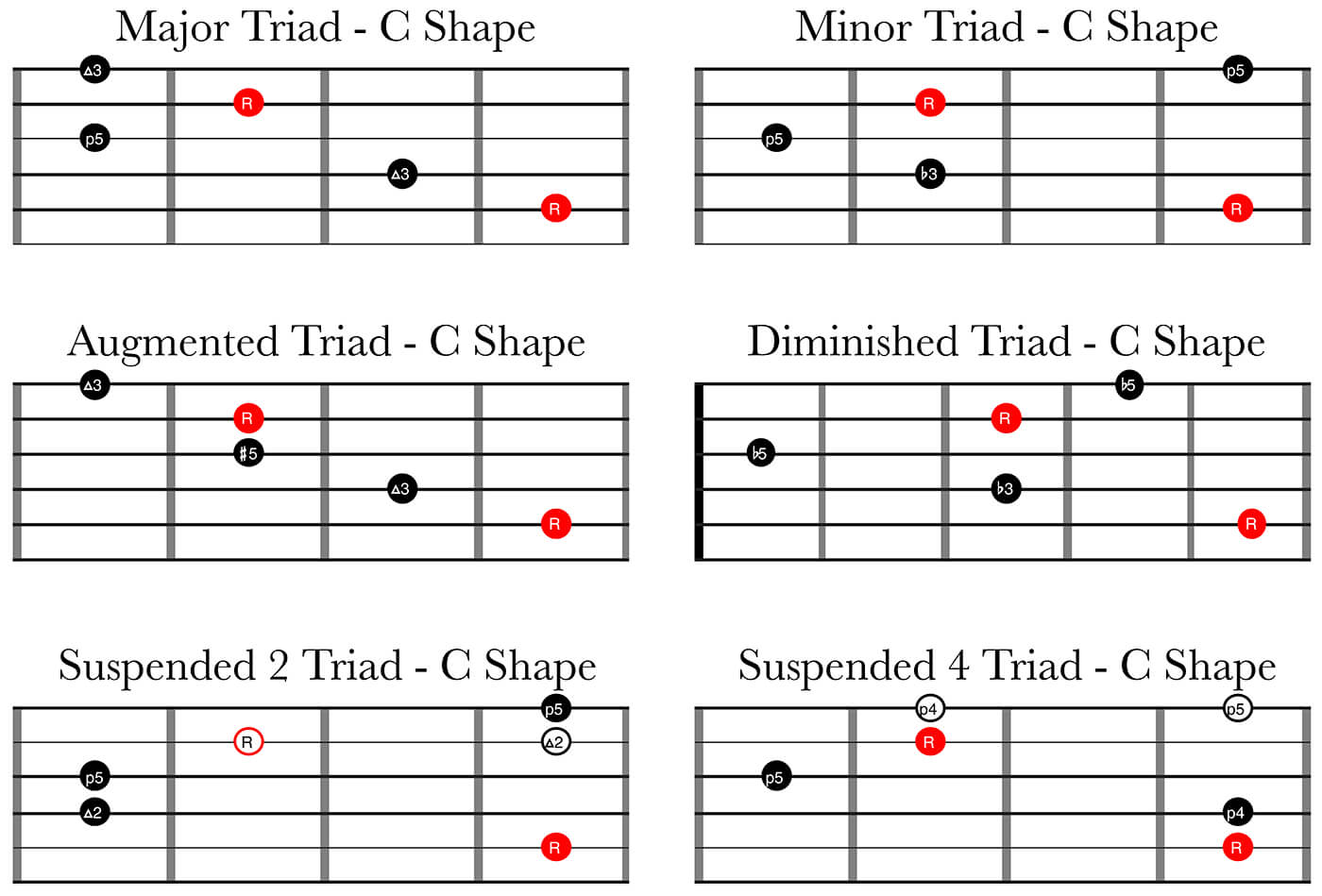
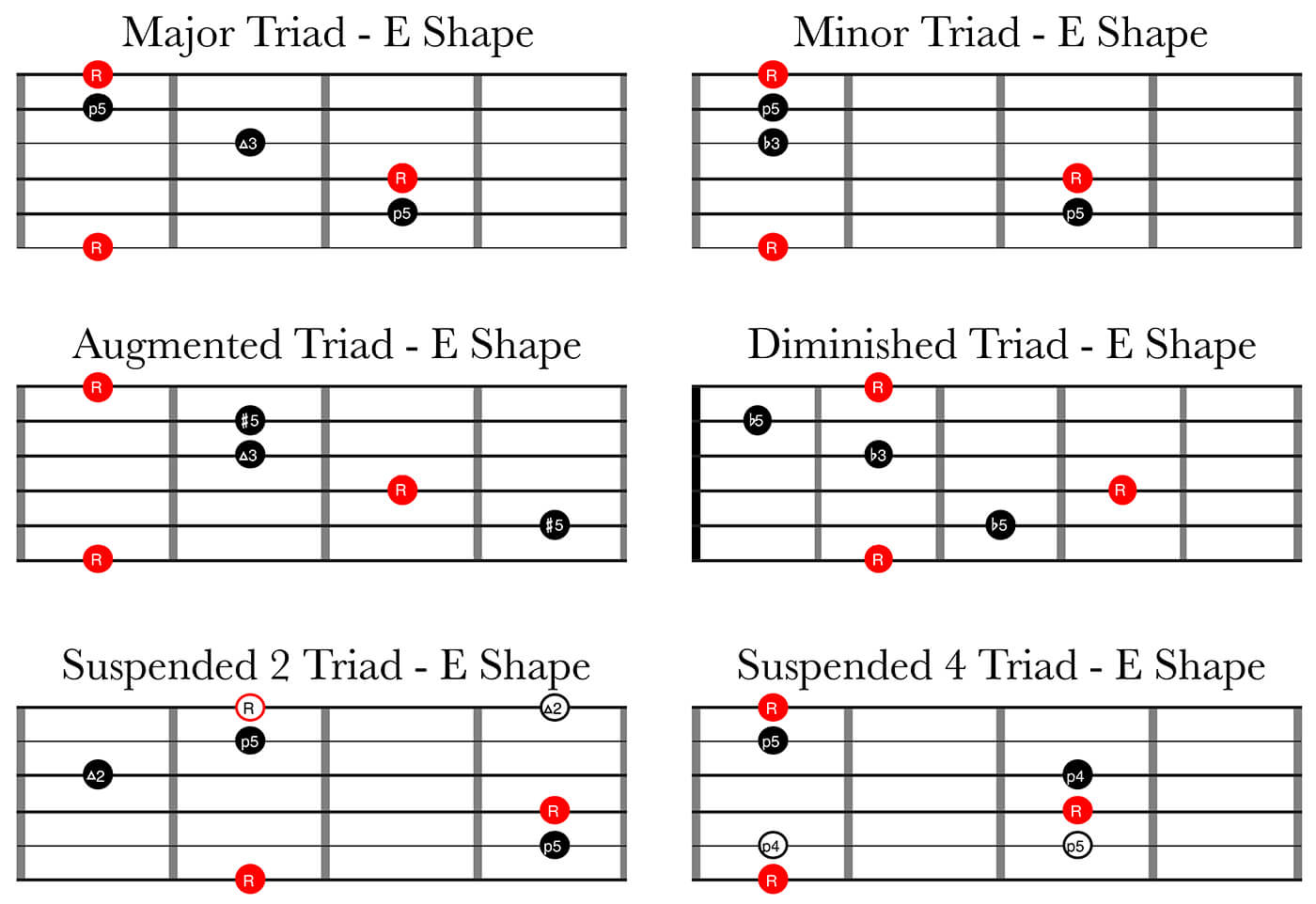
Adding a fourth note to the chords
We’re gonna look at this from the angle of harmonizing a major scale. Let’s do it in the key of B♭, just to get away from C as our key center for a little while. The B♭ major scale contains the following notes: B♭, C, D, E♭, F, G, A. To harmonize a major scale we’ll stack thirds from each given starting point. That basically means we’ll skip every other note of the scale, so with B♭ as our starting point we get: B♭, D, F, A. Now we have our basic triad with the A note added, the A is a major 7th apart from B♭ so now we’ve constructed a major 7th chord – often written as maj7 or a triangle.
We can also see it as the following scale formula: 1-3-5-7. It’s really worth practicing being able to see the interval both from the root note and the previous note of the chord. So in this case B♭ to D is a major 3rd apart, F is a perfect 5th from the B♭ and a minor 3rd from the D, A is a major 7th above the B♭ and a major 3rd from the F. The next step is to analyse what kind of 7th chord we’ll get when stacking thirds likes this, then we have to see each starting point as a ”new root note”. I’ll give some info away while I want you to try to figure out the rest on your own. I’m quite sure you’ll learn on a deeper level this way.
You should know this from above:
| B♭ | D | F | A |
C-E♭-G is a minor triad, with the B♭ added we get a C minor 7th chord. 1-♭3-5-♭7 equals m7:
| C | E♭ | G | B |
Compare the intervals of this to the Cm7 above:
| D | F | A | C |
Now compare this to the B♭maj7:
| E♭ | G | B♭ | D |
F-A-C is major triad, when we add Eb, the flat 7th, we create a F dominant 7th chord:
| F | A | C | E♭ |
This shares the formula with two other chords above, can you figure out which two?
| G | B♭ | D | F |
A-C-E♭ is a diminished triad, with the flat 7th (G) we get an Am7♭5 chord, this could be pronounced both ”A minor 7 flat 5” or ”A half diminished”:
| A | C | E♭ | G |
As you see, there are a few different ways to express how these chord are constructed. It’s important to understand all of them to be able to communicate with other musicians, when playing only by yourself it usually enough to understand it from one perspective. To summarize you should memorize these four different scale formulas from above:
Major 7: 1-3-5-7 or stacking root – major 3rd – minor 3rd – major 3rd
Minor 7: 1-♭3-5-♭7 or stacking root – minor 3rd – major 3rd – minor 3rd
Dominant 7: 1-3-5-♭7 or stacking root – major 3rd – minor 3rd – minor 3rd
Minor 7 b5 or Half Diminished: 1-♭3-♭7-♭7 or stacking root – minor 3rd – minor 3rd – major 3rd
Now let’s check this out on the fretboard in the A and G shapes. But as always, make sure to spend time with all the five shapes to really connect the fretboard. Again, you don’t have to play all the strings, but make sure all the four notes from each chord formula is present.
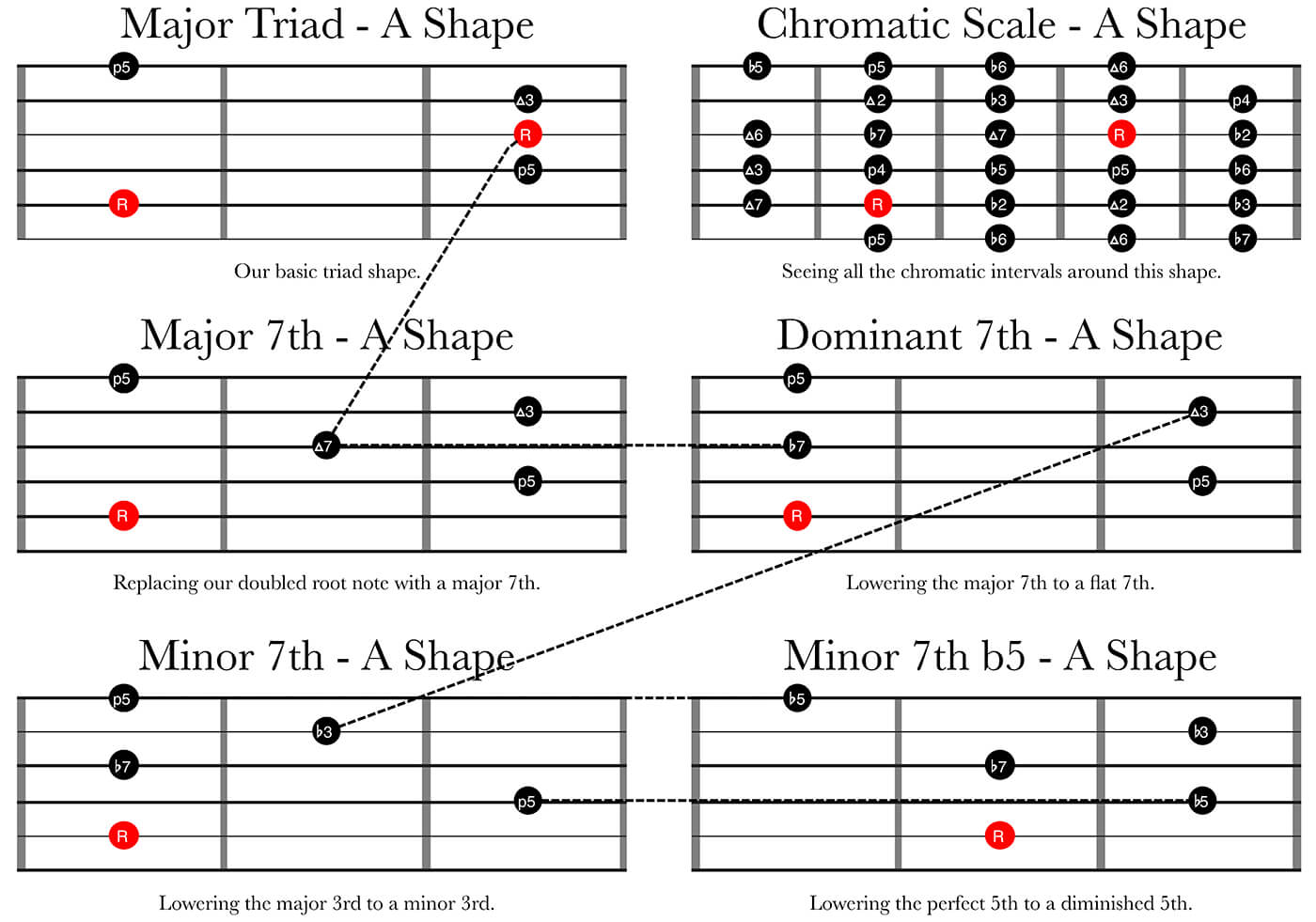
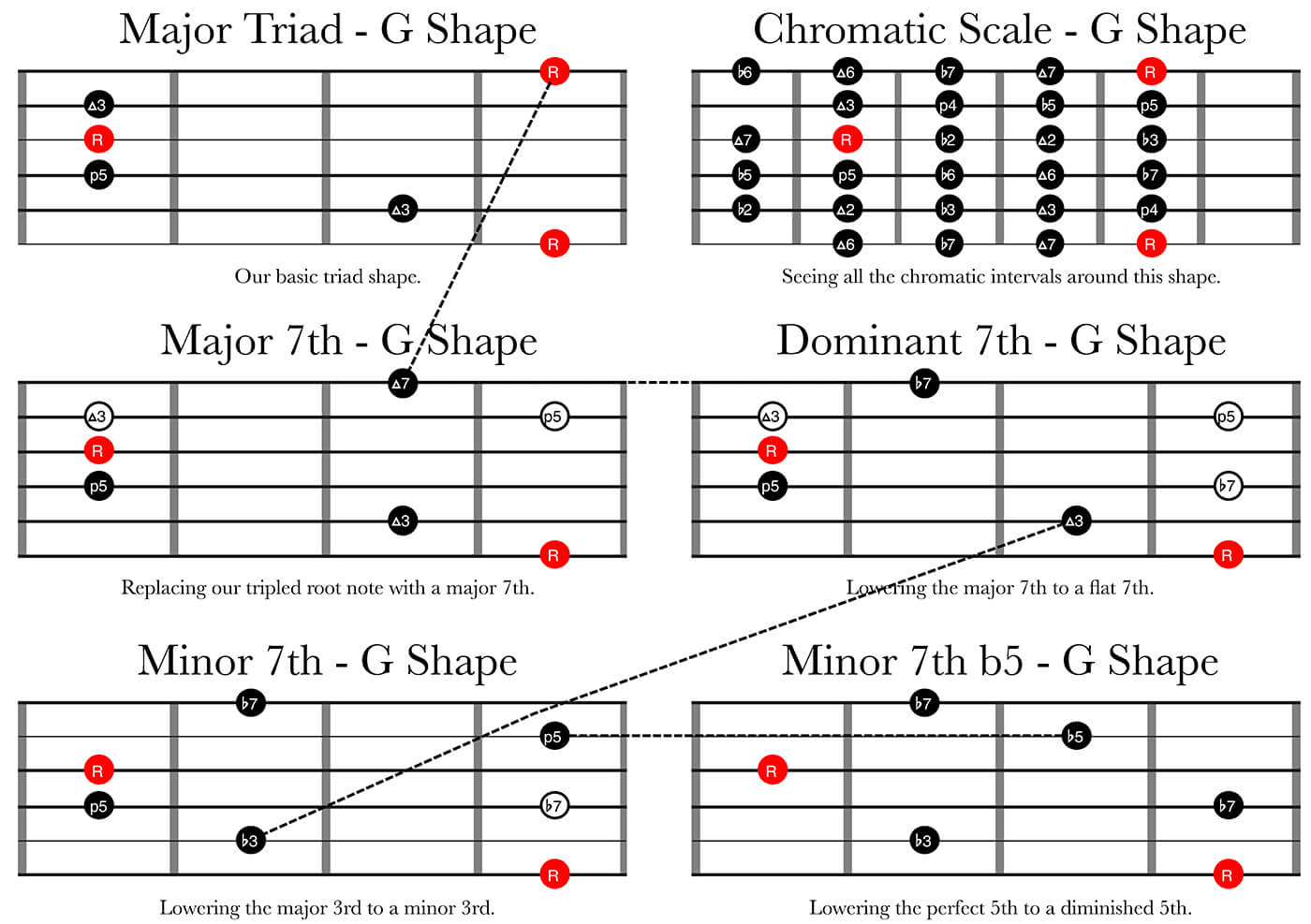
There are three common chord types that replaces the 7th degree with a major 6th instead.
The Major 6th chord has the following formula: 1-3-5-6
The Minor 6th chord has the following formula: 1-♭3-5-6
The Diminished 7th chord has the following formula: 1-♭3-♭5-♭♭7 (this is called a double flat 7th and it sounds the same as the major 6th)
Here’s a task for you: Find one voicing for each of these chord types in all the CAGED shapes.
TIP: The root note doesn’t have to be the lowest note, just make sure to get all four notes from the formula. Avoid doubling any intervals, that’ll help you get a clearer and less muddy voicing.
Let’s go beyond the 7th!
If we continue to stack thirds we’ll also end up with a 9th, 11th and 13th. These share the note name with the 2nd, 4th and 6th. For example; in the key of C the D note can be referred to as both the major 2nd and major 9th. The F note can be both the 4th and the 11th and the A note can be called the 6th or 13th. In the case of sus chords, when the major 2nd or perfect 4th replaces the 3rd of a chord, we call these notes 2 or 4. When the 3rd is still in the chord it’s more common to use the extended interval names 9 and 11.
In the case of choosing between 6 or 13, the rule is to use 13 when the 7 is already in the chord. So 1-3-5-6 would be a major 6 chord, 1-3-5-7-13 would be a major 13. Even if the chord is not voiced in this order, we still think of stacked thirds as our basic chord constructing method. Let’s try adding some upper extensions to the Cmaj7. When we add a D note the chord is simply called a Cmaj9, the formula would be 1-3-5-7-9. It’s less common to add the 4th or 11th to a maj7 as the major 7th and the 4th/11th create a tritone interval together. That reminds our ears a lot of the tritone between the major 3rd and flat 7th of a dominant chord, so this can end up causing harmonic confusion, sort of.
A common solution is to raise the 11th a half step, in the key of C to an F♯ note, that will give us a Cmaj7♯11. The 4th/11th is obviously also a half step above the major 3rd which also creates an unpleasant (most of the time, at least) dissonance. In theory the formula is 1-3-5-7-9-♯11 but since it can be hard to find fingerings that work it is common to omit one or a few notes. The most common interval to skip is the 5th, since it doesn’t really contribute to any harmonic color in this case.
Sometimes you can also skip the 9th or even the root (in a band context we usually trust bass players to hit the root note, right?). Adding the A note would give us a Cmaj13 chord – here we MUST skip some note/s, at least if we’re playing a regular six-string guitar. Why? Well, because if we stack thirds all the way up to the 13th we’ll have: 1-3-5-7-9-11-13. That’s 7 notes and we just have 6 strings. How to tell which interval to omit? Use the same rules as above but skip the 11th/♯11th as well, if you don’t want that particular flavour. Now let’s see what this looks like on the fretboard!
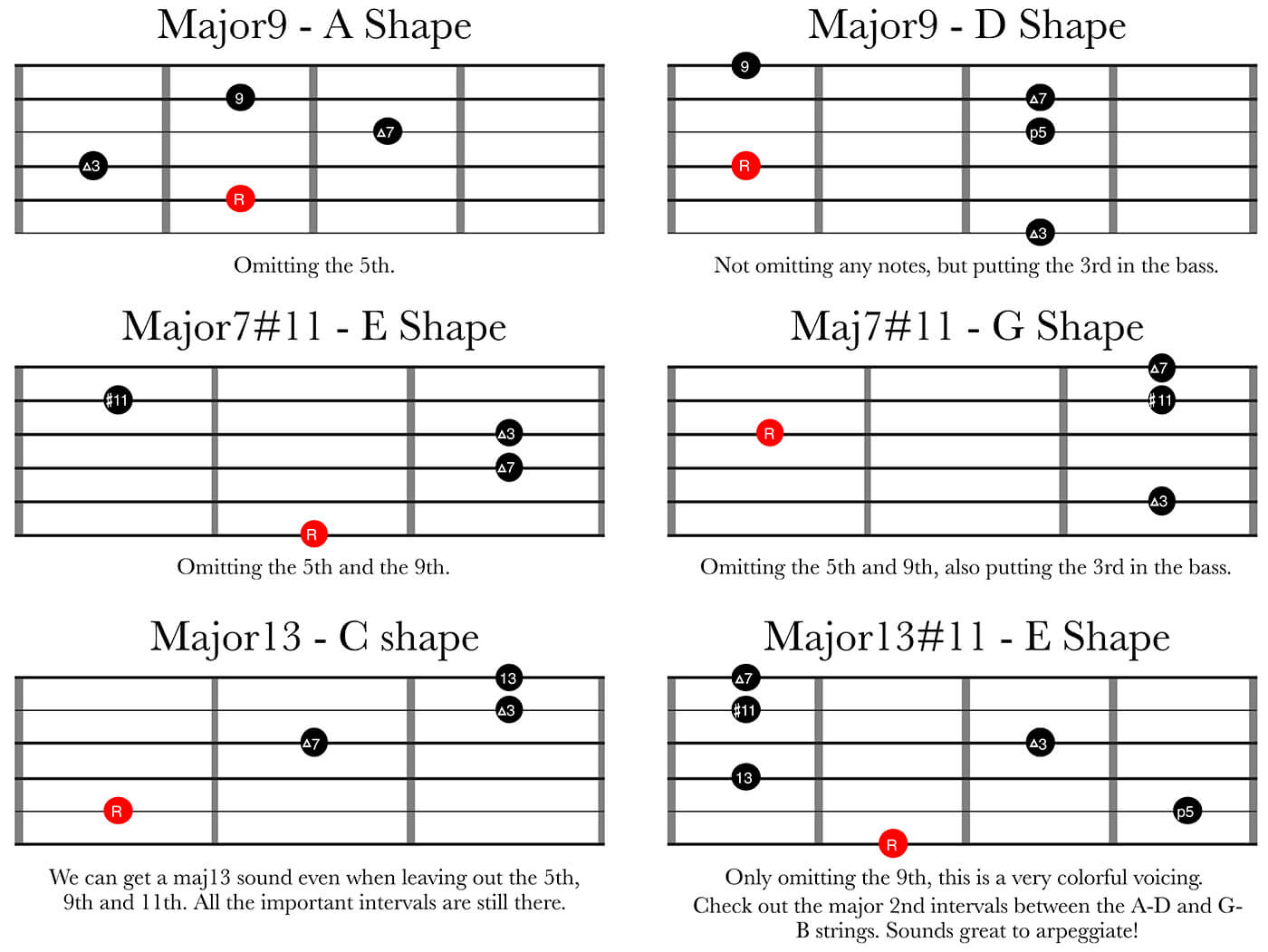
As long as a chord has the 7th degree in it, we usually name it by it’s highest extension. For example 1-3-5-♭7-9 would be called a Dominant 9th chord – we have the dominant 7th chord as our base, we add the flavour of the 9th degree but it’s still a dominant functioning chord. If we add the 9th to a regular major or minor triad it’s called Add 9 – this would be 1-3-5-9 or 1-♭3-5-9. But since I mentioned extended dominant chords, let’s dive a bit deeper here.
A dominant chord usually has the function of adding tension in a chord progression, it usually shows us a certain harmonic direction and wants to resolve into something more harmonically stable. The reason a dominant chord is less harmonically stable then a regular major triad for example is that the distance between the major 3rd and flat 7th creates a tritone interval which is very dissonant in itself, together with the rest of the notes it might not sound that dissonant but it still usually has a feeling of ‘don’t stay here too long, you should move on to another chord’. This is especially true when you start to add some upper extensions.
As with the major 7th chord family we can add the 9th, 11th and 13th. When adding the 11th to a dominant chord it’s very common to omit the major 3rd, this kinda gives us a dominant sus sounding chord since we have the 4th/11th but no major 3rd. You can also go quite a bit further with dominant chords. Since the purpose is to inject some tension to the chord progression we can also start altering some of the notes. It’s common to raise or lower the 9th or the 5th, these create a sub group of dominant chords called Altered Dominant Chords.
If you see something like E7♯9 or B♭7♭9♯5 those are examples of altered dominant chords. It’s worth mentioning that even if we usually pronounce it as ‘E dominant nine’ or even just ‘E nine’ it’s rare to see the word dominant written in a chord chart. If you see a chord with numbers after the letter and no indication of major or minor, it’s save to assume it’s a dominant chord. Major can be indicated as: maj, maj7, M, M7 or a triangle. Minor can be indicated as: m, min or a minus sign (-). Okay, let’s head over to the fretboard again and check out some dominant chord voicings.
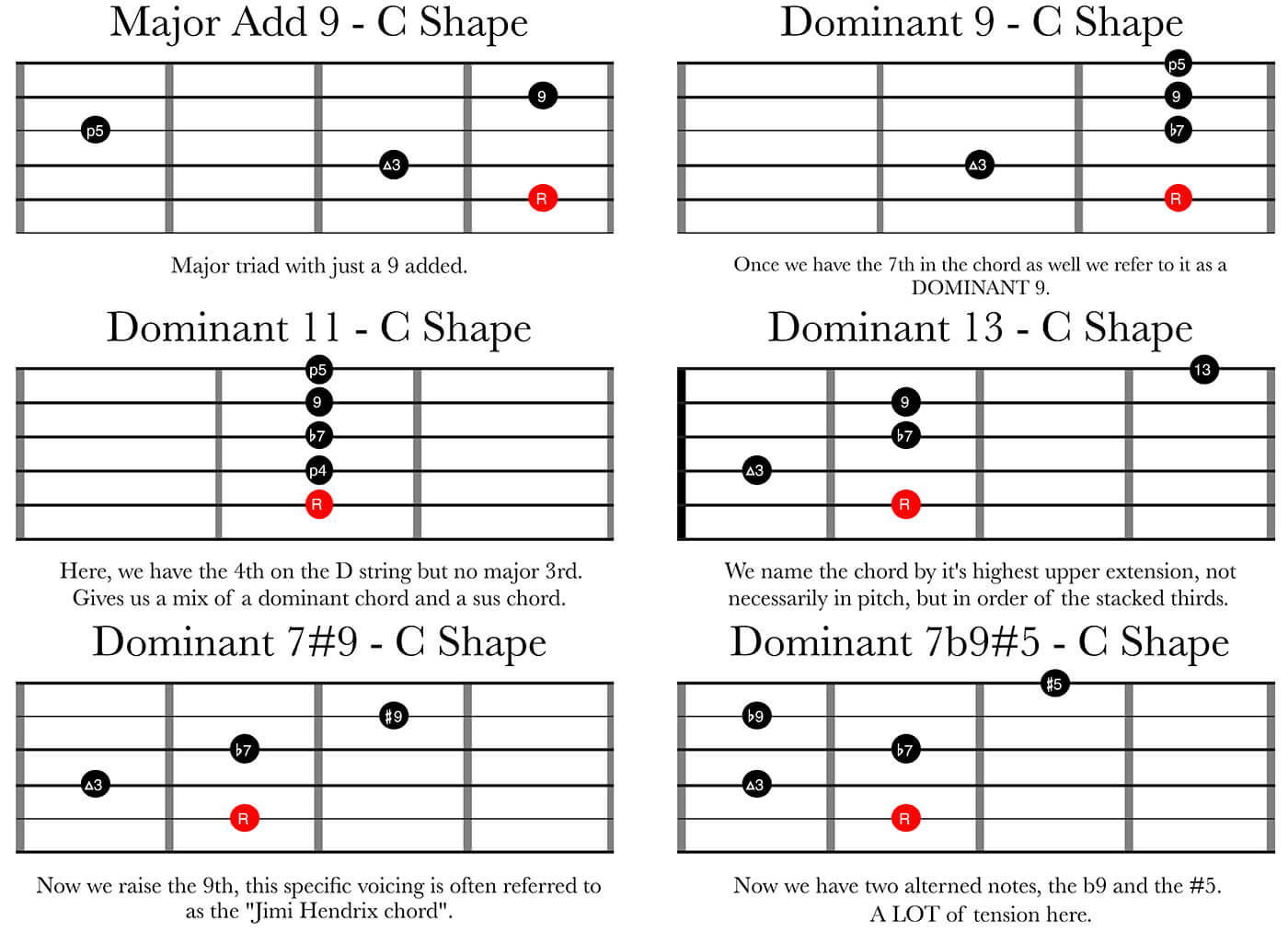
Let’s also look at some variations of extended minor chords. Adding the 9th and the 11th is very common and colorful. Adding the 13th is cool and funky but can get close to a dominant sound because of the tritone interval between the minor 3rd and and 13th, so this has to be used with caution. We can also raise the 7th and play a major 7th, creating a Minor Major 7th chord. Here are some voicings for extended minor chords.
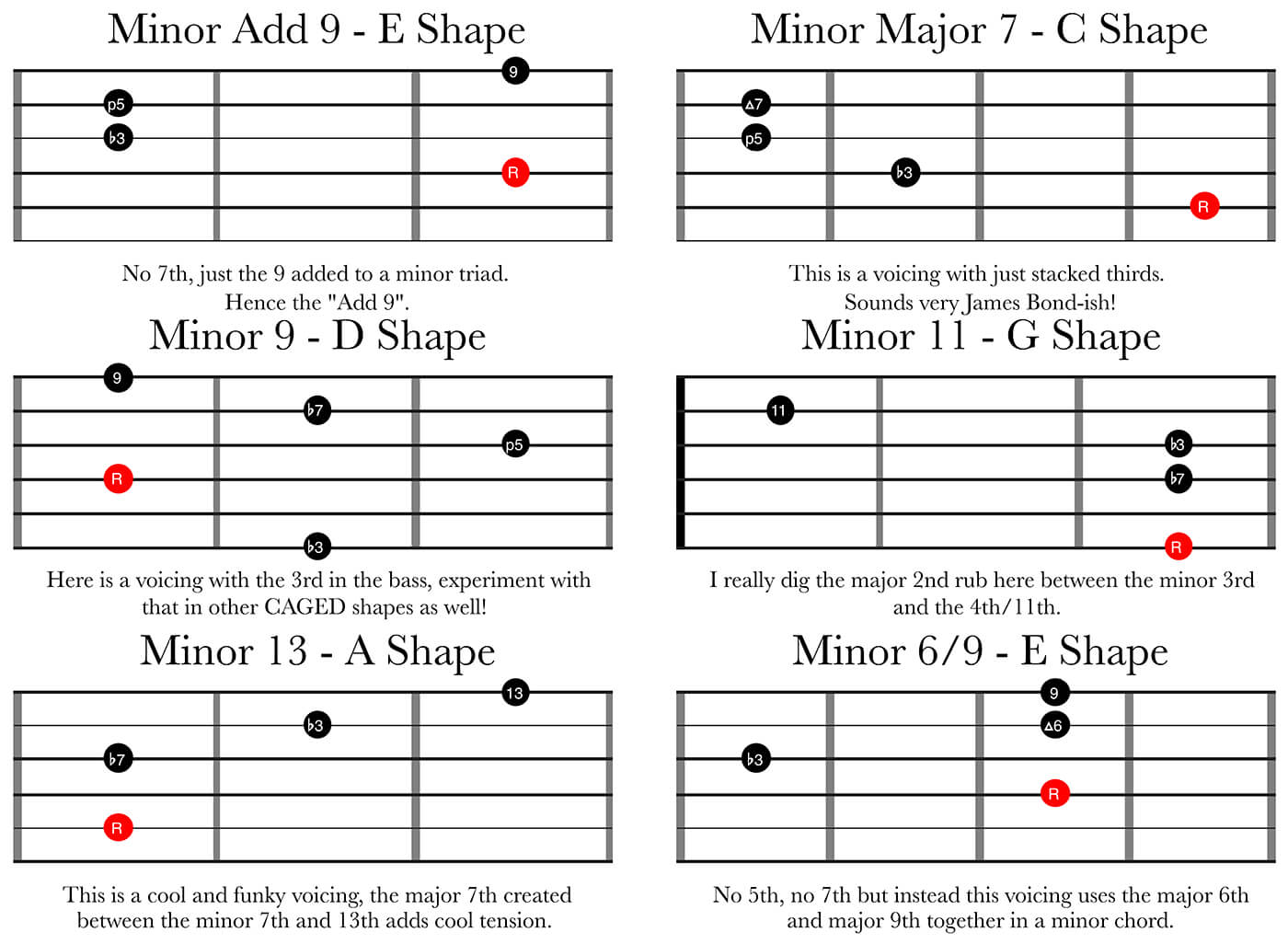
I hope this lesson has given some insight and inspiration. Combined with the 3 previous parts about the CAGED system, you should now start to see how all intervals can be found within any given shape. With the knowledge of chord formulas and how to add upper extensions to the major, minor and dominant chord families you should be able to figure out most chords you come across. Remember that omitting certain intervals doesn’t have to be a bad thing, it gives the rest of the musicians more space which is usually good. Especially when playing in bigger ensembles. Keep on extending that fretboard, there’s always more stuff to explore! Have fun!
Learn from your favourite guitar players here.
